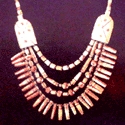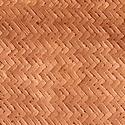In Bhutan, paper-making was traditionally practised as a domestic activity. Paper was made entirely by hand from the bark of the Daphne plant and gum from a creeper root. Often the Daphne bark was mixed together with other barks and roots to yield different varieties of paper. What made the Daphne paper special was its luminosity and texture and the quality of its being termite and insect repellent – it was thus particularly valued for writing religious scriptures and historical records.
The National Museum, Paro has a collection of rare manuscripts written on Daphne paper. The National Library contains about 6,100 Tibetan and Bhutanese books, both manuscripts and xylographs and a collection of 9,000 printing boards.
ORIGINS & TRADITIONS
The handmade paper industry in Bhutan stems from an age-old handicraft tradition whose history can be traced back to the eighth century. The technique of hand paper making, seems to have originally come from China, via Tibet, over the ancient trade routes, to its neighbouring countries, Nepal and Bhutan. Even today, these Himalayan countries continue to share a common method and tradition of making and using handmade paper from the Daphne plant.
Most historical writing in Bhutan has been religious. A religious book is considered sacred because it represents the speech of Buddha. Beautifully written manuscripts on separate sheets of centuries old Daphne handmade paper are still extant in a surprisingly well-preserved state. It is possible to see some of these books, printing boards and paper at the National Library in Thimphu.
PRACTITIONERS & LOCATIONS
Paper was first made in northern, central and eastern Bhutan where the Daphne bush is found in abundance. Although paper-making was practised as a domestic activity in the past, it has now undergone rapid modernisation and taken on the form of a commercial industry. This has eliminated hard laborious work to some extent; more notably, however, it has changed the scale of operation. In Thimpu, large units with equipment imported from Japan are producing and exporting fine qualities of paper and paper products all over the world.
Dagna, south of Thimpu, is known for its thick handmade paper, made from the pulp of the Daphne tree. Thimpu, Tashigang, Punakha, Bumthang and Mongyr districts, and Gedu, all produce paper.
RAW MATERIALS
The dense mountainous regions are the natural habitat of the high altitude plant Daphne, belonging to the plant family Thymelaeacae. In the Himalayan regions, the Daphne comprises 70 species and grows in altitudes ranging from 1,500 feet to 10,000 feet above sea level. The Daphne – a small shrub with fragrant white flowers that cover the slopes around the prayer flags – has a pervasive scent.
The bush is mainly found among the conifers or deciduous trees. When harvested, 5-6 foot tall plants are cut down to a size of about six to eight inches, leaving the main root intact, so that new main shoots can grow and mature for another harvest. In about approximately four to eight years the plant regenerates itself and can be cut again for use.
The paper from the Daphne is usually natural toned, dark woodish and highly durable, capable of lasting over 2,000 years. Ivory coloured paper is made from the strong inner bark, which is stripped, cleaned and then processed. The Daphne plant has tremendous tensile strength and, like elastic, can be coiled, twisted and turned without breaking.
The Edgeworthia papyrifera sieh belonging to the Thymelaeacae – the same plant family as the Daphne – is found at the height of 1,000-2,000 feet and also popularly used in the production of paper. The paper from Edgeworthia is light in colour, softer and less glossy in appearance. It has less strength and durability as compared to Daphne paper.
Some climber plant barks and roots and other ingredients are added for colour, while flowers and petals, leaves, ferns, fern moose, wood moose, banana plants, beetle-nut and maize leaves are added for making floral ornamental decorating papers. Gum is obtained from a creeper root.
PROCESS & TECHNIQUE
The Daphne is harvested during the summer months (March to October), for in winter the skin and bark are stuck together and have to be separated. The inner bark is stripped from the Daphne plant, and dried immediately. This debarking generally takes place in March-April. Local manufacturers of paper buy the Daphne or other bark in a dried form, from contractors. The plants grow wild in various parts of the country, namely the Gedu ranges between Thimpu and Punakha, Trashigang, Mongyr, and Bumthang providing raw materials to the paper units of the area.
The bark is cleaned and cut into small pieces and boiled in water for a couple of hours. Wood ash is added to the water to speed the cooking process without altering the paper tone. This makes the fibre softer and more pliable and therefore easier to reduce to pulp. No chemicals are added – the whole process is natural. These days wood ash is being replaced with caustic soda to further speed up the whole process. This reduces the quantity of wood ash required and at the same time speeds the breakdown of the fibre. Boiling and breaking down the fibre involves a long cooking process. The cooked fibre is now sorted out and put under water – to clean and for the remaining impurities to drain away.
The boiled fibre is pounded by hand or machines (beaters) into pulp. Water is added as and when required to further loosen and break up the fibres into a finer pulp. If the paper has to be coloured then natural dyes – brown from the walnut bark, orange from the madder etc. (Refer section on natural dyes under textiles) – are previously prepared and added to the pulp while it is being beaten. The pulp is pounded thoroughly, in wooden troughs, to make it soft and homogeneous in nature. Water is added in sufficient quantities to ensure that the mixture is of the required consistency. Any dirt or foreign body in the pulp is removed, after which it is ready for paper-making.
In Bhutan two methods are used for obtaining the finished sheets – tsharsho and resho.
- The method widely used throughout the Himalayas produces paper called resho, or ‘cotton paper’. The process begins with the pouring and sieving of the pulp onto a cotton screen; it is then spread uniformly over the cotton surface while floating in water. This manoeuvre requires dexterity and practice. The screen and the pulp are then left to dry, which takes half a day, before the sheet of paper can be taken off. If the weather is wet and cold the drying is done by lighting wood-fires and placing the frames around these.After removing the mould from the water, it is held aloft for a few minutes to drain out the excess water. It is then placed tilted on the ground and allowed to dry in the sun or near a fire. Once dry, the sheet of paper is peeled off the cloth and the mould can be reused. The paper sheet is now ready.
- The other method of making paper is only used in Bhutan and produces a kind of paper called tsasho, or ‘bamboo paper’. A screen made from slim bamboo mat/sticks is lowered into the vat of pulp; the wooden frame and bamboo mesh are vigorously moved, the paper-maker then lifts it out and spreads the pulp over the surface of the screen while it is out of the water. The screen is subsequently turned over, and the sheet that has formed on it drops off and is put on a growing pile of freshly made paper. The mesh, pressed and left to drain the remaining water, leaves a bamboo imprint on the sheet.At the end of the day, a stone is placed on the pile to help the water drain out of it during the night. The next day, the sheets are peeled off one by one and stuck to earthen walls of a hut, built for this purpose. By the end of the day the sheets are dry and fall off the wall. Today, dryers are being used to dry the sheets and speed up the process.
Resho paper is quite thin as compared to the tsharsho and also costs less. Both tsharsho and resho papers were used traditionally for writing holy scripts, legal acts and letters and both are of high quality and last for many centuries.
PRODUCTS
Daphne paper is impervious to insects, durable, glossy, smooth and soft and easy to recycle. The paper in its un-dyed, natural ivory appearance has a silken texture that is most appealing.
The sheets of paper are now being turned into more contemporary products such as greeting cards, stationery sets, notebooks, photo albums, gift wrapping paper, files and folders, bags, envelopes, photo frames, postcards and other stationery items, as well as bags, lamp shades and calendars.
SOME PAPER UNITS IN THIMPU
Jungshi Paper Manufacturing Company
P Box No 506, Thimpu Bhutan
Tel: 975 – 2 – 323431, 321442®
E-mail: [email protected]Mangala Handmade Paper House
Opposite the river, (Above Jungshi Paper Manufacturing Company)
Thimpu, Bhutan
STEP-BY-STEP PROCESS
 |
 |
 |
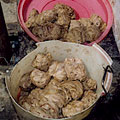 |
 |
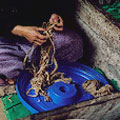 |
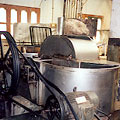 |
 |
 |
 |
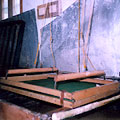 |
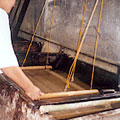 |
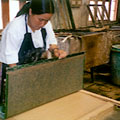 |
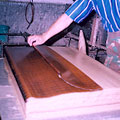 |
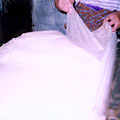 |
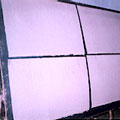 |
Gallery
YOUR VIEWS
PRACTITIONERS: INDIA
Access 70,000+ practitioners in 2500+ crafts across India.
BIBLIOGRAPHY
10,000+ listings on arts, crafts, design, heritage, culture etc.
GLOSSARY
Rich and often unfamiliar vocabulary of crafts and textiles.
SHOP at India InCH
Needs to be written.





